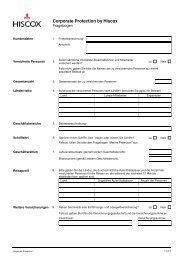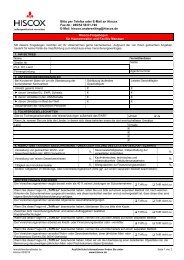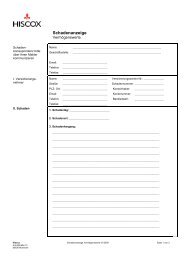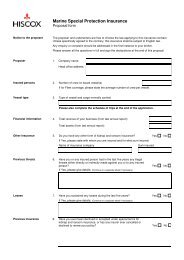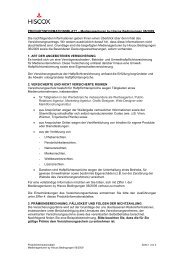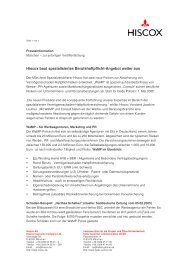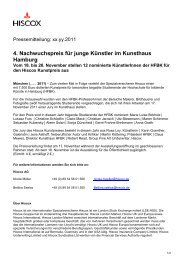Download PDF - Hiscox
Download PDF - Hiscox
Download PDF - Hiscox
You also want an ePaper? Increase the reach of your titles
YUMPU automatically turns print PDFs into web optimized ePapers that Google loves.
Notes to the consolidated<br />
financial statements<br />
continued<br />
27 Insurance liabilities and reinsurance<br />
assets continued<br />
The gross claims reported, the loss<br />
adjustment expenses liabilities and the<br />
liability for claims incurred but not reported<br />
are net of expected recoveries from salvage<br />
and subrogation. The amounts for salvage<br />
and subrogation at the end of 2009 and<br />
2008 are not material.<br />
27.1 Insurance contracts assumptions<br />
(a) Process used to decide on<br />
assumptions<br />
The risks associated with insurance<br />
contracts and in particular with casualty<br />
insurance contracts are complex and subject<br />
to a number of variables that complicate<br />
quantitative sensitivity analysis. Delays in<br />
the notification of claims necessitate the<br />
holding of significant reserves for liabilities<br />
that may only emerge a number of<br />
accounting periods later.<br />
The impact of inflation on ultimate claim<br />
estimates is therefore significant. In addition<br />
a greater level of risk may be inherent in<br />
reserving estimates for newer types of<br />
insurance products where there is a lack<br />
of past historical development experience.<br />
For all risks, the Group uses several<br />
statistical methods to incorporate the<br />
various assumptions made in order to<br />
estimate the ultimate cost of claims.<br />
The reserves for outstanding claims are<br />
actuarially estimated primarily by using<br />
both the Chain Ladder and Bornhuetter-<br />
Ferguson methods. There is close<br />
communication between the actuaries<br />
involved in the estimation process and<br />
the Group’s underwriters to ensure that,<br />
when applying both estimation techniques,<br />
both parties are cognisant of all material<br />
factors relating to outstanding claims,<br />
and allowance is also made for the<br />
rating environment. Catastrophe events<br />
which are expected to impact multiple<br />
business units in the Group are analysed<br />
by the central analysis team. They combine<br />
information from underwriters, the claims<br />
team and past experience of similar events<br />
to produce gross and net estimates of<br />
the ultimate loss cost to each part of the<br />
Group. These figures are then incorporated<br />
by the acturial team into the quarterly<br />
reserving exercise. This process ensures<br />
that a consistent approach is taken across<br />
the Group.<br />
The Chain Ladder method is adopted for<br />
mature classes of business where sufficient<br />
claims development data is available in order<br />
to produce estimates of the ultimate claims<br />
and premiums by actuarial reserving group<br />
and underwriting year, or year of account for<br />
the managed Syndicate. This methodology<br />
produces optimal estimates when a large<br />
claims development history is available<br />
and the claims development patterns<br />
throughout the earliest years are stable.<br />
Where losses in the earliest underwriting<br />
years or years of account have yet to fully<br />
develop, a ‘tail’ arises on the reserving<br />
data, i.e. a gap between the current stage<br />
of development and the fully developed<br />
amount. The Chain Ladder methodology<br />
is used to calculate average development<br />
factors which, by fitting these development<br />
factors to a curve, allows an estimate to be<br />
made of the potential claims development<br />
expected between the current and the fully<br />
developed amount, known as a ‘tail<br />
reserve’. This tail reserve is added to the<br />
current reserve position to calculate the<br />
total reserve required.<br />
Chain Ladder methods may be applied<br />
to premiums, paid claims or incurred claims<br />
(i.e. paid claims plus case estimates).<br />
The basic technique involves the analysis<br />
of historical claims development factors<br />
and the selection of estimated development<br />
factors based on this historical pattern.<br />
The selected development factors are then<br />
applied to cumulative claims data for each<br />
accident year that is not yet fully developed<br />
to produce an estimated ultimate claims<br />
cost for each accident year.<br />
Chain Ladder techniques are less suitable<br />
in cases in which the insurer does not have<br />
developed claims history data for a particular<br />
class of business (e.g. in relation to more<br />
recent underwriting years or years of<br />
account). In these instances the Group’s<br />
actuaries make reference to the Bornhuetter-<br />
Ferguson method.<br />
The Bornhuetter-Ferguson method is based<br />
on the Chain Ladder approach but utilises<br />
estimated ultimate loss ratios. This method<br />
uses a combination of a benchmark or<br />
market-based estimate and an estimate<br />
based on claims experience. The former<br />
is based on a measure of exposure such<br />
as premiums; the latter is based on the paid<br />
or incurred claims to date. The two estimates<br />
are combined using a formula that gives<br />
more weight to the experience-based<br />
estimate as time passes. This technique<br />
has been used in situations in which<br />
developed claims experience was not<br />
available for the projection (recent accident<br />
years or new classes of business).<br />
88 Notes to the consolidated financial statements <strong>Hiscox</strong> Ltd Report and Accounts 2009<br />
In exceptional cases the required provision<br />
is calculated with reference to the actual<br />
exposures on individual policies. Adjustments<br />
are made within the claims reserving<br />
methodologies to remove distortions in<br />
the historical claims development patterns<br />
from large or isolated claims not expected<br />
to re-occur in the future. In addition,<br />
the reserves determined for the managed<br />
Syndicate are converted to annually<br />
accounted figures using earnings patterns<br />
that are consistent with those for the<br />
underlying Syndicate business.<br />
The choice of selected results for each<br />
accident year of each class of business<br />
depends on an assessment of the technique<br />
that has been most appropriate to observed<br />
historical developments. In certain instances,<br />
this has meant that different techniques<br />
or combinations of techniques have been<br />
selected for individual accident years or<br />
groups of accident years within the same<br />
class of business.<br />
(b) Claims development tables<br />
The development of insurance liabilities<br />
provides a measure of the Group’s ability<br />
to estimate the ultimate value of claims. The<br />
Group analyses actual claims development<br />
compared with previous estimates on an<br />
accident year basis. This exercise is performed<br />
to include the liabilities of Syndicate 33<br />
at the 100% level regardless of the Group’s<br />
actual level of ownership, which has<br />
increased significantly over the last eight<br />
years. Analysis at the 100% level is required<br />
in order to avoid distortions arising from<br />
reinsurance to close arrangements which<br />
subsequently increase the Group’s share<br />
of ultimate claims for each accident year,<br />
three years after the end of that accident year.




